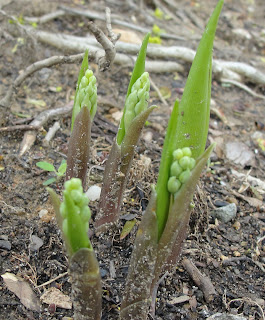| Peep, peep! |
All you need to do is follow the recipe for marshmallows from my previous post. I used four envelopes of gelatin instead of two--I wanted to make sure the marshmallow would hold it's shape when I made the peep shape. Also, I let it whip a little longer than usual to the point that the marshamallow didn't flow off the whisk like it usually does, but is thicker.
| This is how you want it: thick and slow. That sounds very weird. |
If it's not thick enough, this is what happens to your peeps:
They turn into slugs. You don't want Easter slugs. So keep your marshmallow in the mixer until it's thick, thick, thick.
Now, for the piping. If you have a piping bag, you can use that. I prefer sacificing a plastic ziplock for this job (this from the mom who washes and reuses her ziplock bags) because it is very sticky and it is larger than my piping bag. Spoon the marshmallow into the bag, zip it closed and cut one of the lower corners off. I make about a half-inch wide hole so the peeps come out full (you don't want skinny worms either).
Pipe onto a baking sheet sprinkled with powdered sugar. Make a body by starting from the back and move forward. Go back about 1/4 of the way to make the head and stop squeezing the bag. Slowly pull foward to make the beak. We made a badly produced video for all you visual peeps (people, in this case. I don't think marshmallow peeps are reading this blog. Or are they?)
Here are my peeps:
| Lazy peeps couldn't even hold their shape! |
They turn into slugs. You don't want Easter slugs. So keep your marshmallow in the mixer until it's thick, thick, thick.
Now, for the piping. If you have a piping bag, you can use that. I prefer sacificing a plastic ziplock for this job (this from the mom who washes and reuses her ziplock bags) because it is very sticky and it is larger than my piping bag. Spoon the marshmallow into the bag, zip it closed and cut one of the lower corners off. I make about a half-inch wide hole so the peeps come out full (you don't want skinny worms either).
Pipe onto a baking sheet sprinkled with powdered sugar. Make a body by starting from the back and move forward. Go back about 1/4 of the way to make the head and stop squeezing the bag. Slowly pull foward to make the beak. We made a badly produced video for all you visual peeps (people, in this case. I don't think marshmallow peeps are reading this blog. Or are they?)
Here are my peeps:
| They look like they're up to something. |
Le them dry for about an hour, use a fork to unstick them from the baking pan, and roll in colored sugar. I bought some naturally colored sugar at Whole Foods a few years ago, and I still have it. I used a mortar and pestle to make it a little finer.
As a finishing touch, use a tooth pick and melted chocolate to give them eyes.
And don't let your good-looking peeps ostracize the slugs. They're all the same, deep down.




